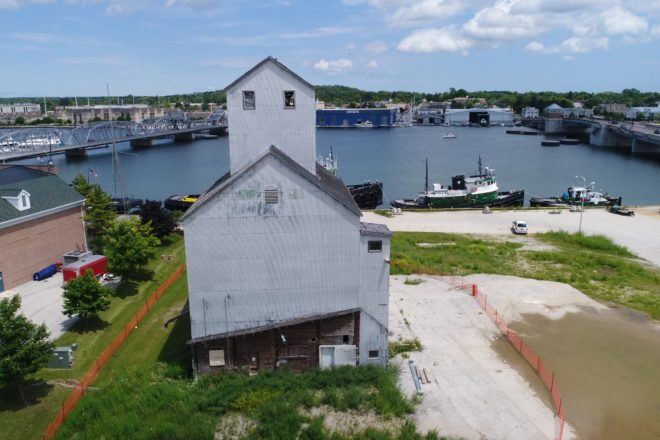Granary Demolition Decision the Latest Strange Turn in Strange Fight
- Share
- Tweet
- Pin
- Share

Members of the Sturgeon Bay Historical Society (SBHS) expected to take a big step toward saving the Teweles and Brandeis Grain Elevator at the Nov. 21 meeting of the Sturgeon Bay Common Council. Instead, they left the chambers distraught after the council voted 4-3 to take the historic structure down.
The historical society was set to present plans for a structural analysis and rehabilitation of the structure, but found out at the start of the meeting that the city’s amended agenda to add the presentation to the docket was posted eight minutes too late. The meeting would instead follow the original agenda, including the razing of the building known to most simply as the Granary.
Now SBHS is trying to get the presentation added to the Dec. 5 council meeting agenda.
“We would like to inform them of the possibilities we had in mind,” said SBHS member Christie Weber.
An anonymous donor had pledged $1.25 million to stabilize and rehabilitate the Granary, and additional pledges had pushed the total to nearly $1.4 million. On Nov. 7 the council voted to give SBHS 60 days to perform a structural analysis of the property on the city’s west waterfront.
But Pat Drury, a historic preservationist working with SBHS, said the city did not let them onto the property to begin evaluations.
The Granary was the centerpiece of the city’s west waterfront redevelopment plans as recently as the fall of 2015, when Titletown Brewing Company proposed redeveloping the property into a brewery and restaurant. Given the enthusiasm the city showed for repurposing the property since the redevelopment plan began in 2010, the decision to turn down $1.4 million in private funding to do so stunned many.
The city’s decision comes with the stipulation that the deconstruction be done in consultation with preservationists to save portions of the structure for possible reconstruction or repurposing. Those portions would be stored for up to one year for an organization to come up with a plan for the pieces, with all expenses incurred by the city.
The $1.25 million pledge had included the stipulation that if, after the structural analysis the Granary was deemed unsalvageable, the money would be used to remove the building.
Though the city had a bid for demolition that set the cost at $53,000, it had to re-open bidding since the cost of deconstructing for preservation purposes is expected to be much greater. The city hopes to have bids to review at the Dec. 5 meeting.
Before voting to demolish the structure, which dates to 1901, the council rejected the option to join the Sturgeon Bay Historical Society in its petition to remove the raze order issued by Fire Chief Tim Dietman Oct. 17. Without the city on board, the historical society does not have legal standing to challenge the order. Alderpersons Kelly Catarozoli, Barbara Allmann, and Laurel Hauser voted in favor of that motion, while Richard Wiesner, Ron Vandertie, David Ward and Stewart Fett voted against it.
The original raze order gave the city until Nov. 17 to raze the structure or risk being cited by the Department of Safety and Professional Services (DSPS) for each day it is not taken down.
Fett said the city has been advised that it could be fined $1,000 for each day it doesn’t comply with the raze order. City Administrator Josh VanLieshout said the city will contact the DSPS to seek time to finalize deconstruction bids and avoid penalties.
In August the council voted to tear down the granary with the stipulation that those interested in saving the structure would have until Jan. 1 to come to the city with proposals for rehabilitative use for the structure, and more importantly, funds for stabilization.
Later that month the granary was added to the Wisconsin Register of Historic Places. Then in October Dietman ordered the structure be razed within 30 days due to concerns for public safety based on a complaint made by a citizen and evaluations by Dietman and city staff. The city has not released any information on what those evaluations revealed.
In 2013, Meyer, Borgman, and Johnson performed a detailed structural analysis of the building and determined it was a great candidate for repurposing. The city included it as a centerpiece of its west waterfront redevelopment plan and sought developers to invest in it, but at least one potential brewery developer deemed rehabilitation too costly and asked the city to kick in substantial funds.



